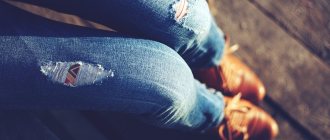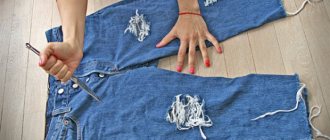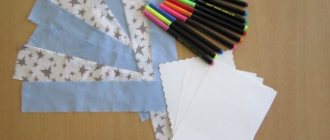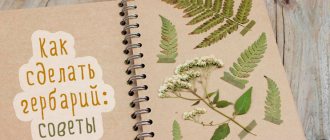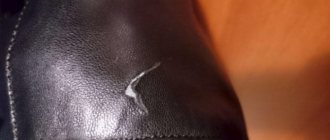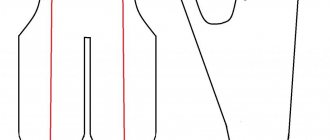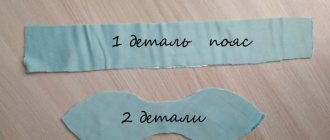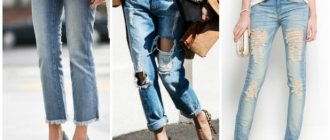With the help of clothes, you can create a unique image that will emphasize external advantages and, if chosen correctly, tell about your character traits. Ripped jeans give their owners both a slight and sometimes open boldness, as well as a certain charm.
In most cases, this wardrobe attribute, compared to the everyday option, has a higher price tag, for which the funds are not always available. But you can make beautiful jeans yourself. This is a good way to get a designer item, a duplicate of which you will not see on anyone else.
From this article you will learn how to make ripped jeans in several ways, and, having studied the step-by-step technology, you will not be limited in your imagination.
How they make abrasions on jeans in a factory
Special equipment is used to process jeans in the factory, and some effects are done manually. For example, to create abrasions they use a sand-room - a special room where a machine directs a high-pressure jet of sand onto the jeans, creating abrasions.
At the factory, abrasions on jeans are achieved using various technologies. After the procedure, the trousers are sent to be washed and dried. A more progressive method is laser treatment, which can produce a very aged effect, as well as a destroy-effect - ripped jeans.
With the help of lazarus, factories achieve the effect of strong aging for jeans. The crease effect is achieved by holding the crease in place and spraying a chemical, such as varnish, which, when cooked, will create stylish wrinkles on the jeans.
The effect of folds is obtained by fixing them and spraying a chemical substance.
Required Tools
Knowing how to tear jeans beautifully with your own hands, you can diversify your usual wardrobe without additional expenses. But you should approach this task responsibly so that the results of your efforts will pleasantly surprise others. Before you begin, make sure you have the following tools:
- Ordinary scissors - if you have experience in making jeans with slits with your own hands, you can achieve excellent results using scissors. If you are starting this kind of work for the first time, it is better to buy a well-sharpened stationery knife. It will be somewhat more convenient to work with such a tool.
- Ideally, a narrow board; in its absence, a strip of high-density cardboard. The product should be narrow enough to fit inside a trouser leg. It will act as a reliable obstacle that prevents the other half of the trouser leg from being cut through.
- Clothes brush with stiff bristles. If you don't have one, an old toothbrush or a wide-toothed comb will do.
- To make complex cuts, you need a nail file, fine sandpaper or pumice. These items help to make original decorative cuts, process their edges and create the effect of aged denim.
- Denim pants - this could be an old model from a fashionista's wardrobe that she is bored with. You can also decorate brand new classic jeans in the desired size with slits.
You can look fashionable in denim clothes without significant material costs if you use the usual tools to create torn decor on the product. But you shouldn’t mindlessly cut denim. Select several photo options with torn jeans, which will allow you to sketch out a diagram of future cuts on your model.
How can you make scuff marks?
You can make holes, scuffs and scratches by hand that will look just as stylish as those made in a factory.
You can make many variations of holes, abrasions and scratches on your jeans by hand. If you are interested in how to make scuffs on jeans at home, then you will need things that every home has:
- metal grater;
- sandpaper or pumice;
- blade or stationery knife;
- chalk for marking.
You can achieve the desired effect on jeans using various available means. Small planks will also come in handy to protect the back of the legs from damage.
The effect you want to get will depend on the chosen method and denim material, so it is recommended to try all the steps on an unnecessary piece of denim, and only then proceed to the main work.
Grater
The grater creates beautiful scuff marks with jagged edges that look best on the knees. Depending on the exposure time, you can adjust the intensity of the effect to slightly age the jeans or, conversely, tear them in several places. In addition to a metal grater (kitchen or for foot care), you will need a board.
Scuffs made with a grater look very good on knees. Map out in advance where you want to age your jeans. Pull your trouser leg onto the board and get to work: work the fabric with light movements so as not to make any larger cuts than necessary. Check the effect periodically, otherwise you may accidentally damage the item.
When using a grater, periodically check the result obtained during the process.
Pumice stone, utility knife or blade
You can make deep, even abrasions using household pumice. It is better if it is coarse-grained.
Using regular pumice you can easily create scuff marks on jeans. First, you need to wet your jeans, since it is recommended to work with pumice on wet denim. Then pull the trouser legs onto the boards and begin to rub the desired areas with pumice, adjusting the intensity of the pressure. With this treatment, the aging effect is as natural as possible. If you treat dry denim with pumice, you will get a fashionable scratch effect.
Preference should be given to coarse pumice. A utility knife or regular blade is used to make cuts that can be beautifully frayed by pulling out the outer threads. A utility knife is used to make cuts on jeans. Mark the places where you want to cut the holes, and then start working with the tool. Horizontal cuts on the front of the jeans look beautiful, and the bottom can be treated with pumice or sandpaper.
Horizontal slits on the front of the jeans look very good.
Sandpaper
Beautiful and correct abrasions can be made at home using sandpaper. Pull the trousers onto the board and begin sanding them to rub down the fabric to the desired effect.
Sandpaper is another tool that can be used to achieve a distressed effect on jeans. Using sandpaper, you can get the most natural abrasions, with which the trousers will look as if they have aged naturally or were purchased with them already. When rubbing your jeans yourself with sandpaper, ensure the uniformity and intensity of the resulting effect so that the item looks fashionable and modern. When used correctly, sandpaper will help achieve a natural scuffed effect.
Wipe jeans only in standard places: on the hips, knees, pockets. You should not create an aged effect where it is not typical, for example, on the front of the shins or on the sides, otherwise it will look implausible.
Which models to choose
First, the question is decided - what the pants will look like as a result. Holes give the owner an attractive appearance, highlight advantages, and distract from shortcomings.
Holes on tight pants that fit tight on plump legs will only emphasize the extra volume of the legs. In this case, it is better to tear wider pants.
Elastic jeans are torn only in the horizontal direction, otherwise, due to stretching of the fabric, the hole will lose its appearance.
If you use pants that are too loose to make holes, the holes will not look good. Because ripped jeans emphasize the beauty and attractiveness of your legs, while in wide pants your legs will be hard to see through the holes.
Any model is suitable for transformation:
- classic denim;
- skinny;
- boyfriend jeans;
- mom jeans;
- shorts and cropped pants;
- bell-bottoms and loose-fitting trousers.
It is easy to make a hole in thin fabric, but it is more difficult to finish the edges, so thick fabric is considered suitable.
In blue denim, the white threads run horizontally and the blue ones run vertically. Due to this contrast, the torn place looks stylish.
Black jeans do not have white threads, so the holes look sharply defined. These pants have narrow slits.
How to make holes in jeans with your own hands at home
In addition to scuffs, fashionable jeans often have holes of various sizes and shapes - from neat perforations to holes with torn edges, through which bare knees are stylishly visible. Making holes in your jeans yourself is as easy as making rips.
With the right approach, making beautiful holes in your jeans yourself can be as easy as making scuffs.
Round holes
Round holes are most often placed on the knees; jeans are difficult to wear out from frequent wear. To make them, you will need scissors, with which you need to carefully cut a small round hole in the right place on the legs. Next, all that remains is to dishevel the products, pulling out the blue threads so that only white ones remain.
Round holes look best on the knees. Round holes that are very frayed at the edges are made like this: make a horizontal cut with scissors, a knife or a blade, and then pull out blue and white threads across the entire area of the hole. You can also leave a certain amount of white threads intact to create a fashionable “scuffed to holes” effect.
Holes with white threads
The trendy effect looks beautiful not only on the knees, but also on the top of the jeans. To create it you will need a blade or scissors, as well as tweezers for pulling out the blue threads.
Such holes can be made not only on the knees, but also on the upper front of the jeans. Take your jeans and mark two horizontal stripes with chalk or pencil at a distance of 2-3 cm from each other. The distance can be larger or smaller depending on how big you want the hole. Make slits, and then begin to carefully remove the blue threads, leaving the white ones. If done correctly, you will get a rectangular hole filled with white threads.
Holes with uneven edges look more realistic, so don’t try to make everything perfect, because holey jeans, by definition, cannot look neat.
lace holes
For a feminine interpretation of ripped jeans, you will need not only a standard set of tools in the form of scissors, a blade and tweezers, but also ready-made lace, crocheted or factory-made. For ease of operation, you also need a sewing machine, although small laces can be sewn on by hand.
Jeans with lace holes look very interesting and original. Make holes in the legs in a way that suits you, you can fray the threads for a grunge effect or leave the edges smooth. Sew lace over the holes using a machine or by hand. In this way, you can process almost the entire surface of the jeans, resulting in completely unique trousers in an elegant style.
Beautiful (neat)
Neat small holes can be made with scissors or a blade by cutting small holes of the desired shape or horizontal slits on the jeans.
Such small and neat holes on jeans can be made using scissors or a blade. If you carefully fray them around the edges, leaving white threads, you get a slight aged effect.
This is how easy it is to “age” your favorite jeans at home, making them more stylish and relevant. Each method is easy to implement and completely safe for health, and in order not to ruin your jeans, stick to a moderate upgrade and periodically evaluate the result of your work.
Preparation for the process
To really make your favorite thing more interesting, and not spoil it, you need to carefully prepare for the process. It only takes a few steps:
- Choose jeans and pay attention to their quality. It will not be possible to make abrasions on a material that is too thin or stretchy. It will not be able to keep its shape, the slits will quickly stretch and will not look so impressive. Medium to heavy weight denim works best.
- Carefully inspect the item and decide where it is most appropriate to make abrasions. Consider your body type and jeans model.
- Having thought through the concept, mark on the fabric the places you will work on using chalk or soap. Put on your jeans and take another look at them from afar, wondering whether such decor would be appropriate in the chosen places.
- Decide on the method you will use and prepare all the necessary tools.
For the final step, check out the most common methods below. Choose a method depending on how strong and noticeable the effect you want to see.
Ideas for rips and holes in jeans that you can do yourself
Ways to decorate jeans
- lace;
Lace perfectly complements fraying and holes in jeans. It is sewn on the inside of the product and hides bare areas of the body. In addition, such inserts prevent damaged denim from deforming, spreading, and increasing in size.
On a note!
Lace can add romance and tenderness to an image.
- dyes;
Using various dyes, you can color the abrasions and edges of holes in denim. The choice of color depends on what clothes we will wear the product with.
- rhinestones;
We decorate the edges of the hole with rhinestones, and also use them to decorate other parts of the product.
- fabric inserts;
We sew fabric inserts on the inside of the product, thus closing the hole made.
- beads.
Beads are a popular decoration for ripped jeans. We first lay them out on the product and select the areas where we will sew them. Mark with a felt-tip pen or marker and sew on.
On a note!
We do not decorate back pockets with beads, as they can come off or cause discomfort while sitting.
Useful tips
Making holes in your favorite pants is a delicate matter and requires taking into account some rules:
- You should never make cuts by eye; it is best to do a preliminary fitting and apply marks at the location of the future cut.
- Use chalk or soap to mark fabric.
- The area on the knees is particularly susceptible to stretching; this nuance must be taken into account when creating an incision of the required size.
- You should not use scissors, as they do not allow you to make straight lines. It is best to use a stationery knife.
- You only need to make cuts when using a backing board. Without it, you can cut right through your jeans with a utility knife.
Knowing how to beautifully rip jeans at the knees and applying these valuable tips, you can transform your outfit without any help.
